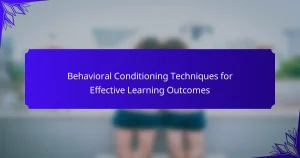Classical conditioning enhances educational practices by creating strong associations between stimuli and responses. This article explores its core principles, applications in reinforcing learning, and techniques for reducing anxiety. It also examines the unique and rare applications of classical conditioning in fostering positive classroom environments and improving student engagement. Finally, we address the limitations and best practices for effective implementation in educational settings.

What are the core principles of classical conditioning?
Classical conditioning is based on the principles of association, reinforcement, and generalization. These principles can enhance educational practices by linking stimuli with desired responses.
The core principles include:
1. **Unconditioned Stimulus (US)**: A stimulus that naturally triggers a response.
2. **Conditioned Stimulus (CS)**: A previously neutral stimulus that, after association with the US, elicits a conditioned response.
3. **Unconditioned Response (UR)**: The natural reaction to the unconditioned stimulus.
4. **Conditioned Response (CR)**: The learned response to the conditioned stimulus.
5. **Extinction**: The gradual weakening of the conditioned response when the CS is presented without the US.
6. **Spontaneous Recovery**: The reappearance of the conditioned response after a pause, following extinction.
These principles can be applied in educational settings to reinforce learning through consistent associations.
How does classical conditioning differ from operant conditioning?
Classical conditioning involves learning through association, while operant conditioning focuses on behavior modification through rewards and punishments. Classical conditioning pairs stimuli to elicit responses, whereas operant conditioning modifies voluntary behavior based on consequences. Both techniques can enhance educational strategies, yet they target different learning processes. Understanding these distinctions can improve teaching effectiveness.
What are the key components of classical conditioning?
The key components of classical conditioning are the unconditioned stimulus, unconditioned response, conditioned stimulus, and conditioned response. These elements work together to create learned associations.
The unconditioned stimulus naturally elicits a response without prior learning. For example, food causes salivation in dogs. The unconditioned response is the natural reaction to this stimulus. In this case, the salivation is the unconditioned response.
The conditioned stimulus is a previously neutral stimulus that, after being paired with the unconditioned stimulus, begins to elicit a response. For instance, if a bell rings before the food is presented, the bell becomes the conditioned stimulus. The conditioned response is the learned reaction to the conditioned stimulus, such as salivation in response to the bell alone after conditioning.
Understanding these components is essential for applying classical conditioning principles in educational settings, such as enhancing student engagement through positive reinforcement strategies.
What role do unconditioned stimuli play?
Unconditioned stimuli play a crucial role in classical conditioning by naturally eliciting a response without prior learning. They are essential for establishing associations between stimuli and responses in educational contexts. For example, a loud noise can automatically trigger a fear response, demonstrating how unconditioned stimuli can facilitate learning through emotional reactions. This principle can be applied to enhance engagement and retention in educational settings by pairing new information with strong emotional or sensory experiences.
How do conditioned responses develop?
Conditioned responses develop through repeated associations between stimuli and responses. Classical conditioning principles illustrate how neutral stimuli can elicit specific reactions when paired consistently with unconditioned stimuli. For example, in educational settings, using rewards can condition students to associate learning with positive outcomes. This process highlights the unique attribute of classical conditioning, where learning occurs through experience rather than direct instruction. Understanding these principles allows educators to create effective learning environments that foster engagement and motivation.

What are the universal applications of classical conditioning in education?
Classical conditioning has universal applications in education, enhancing learning and behavior modification. It helps create associations between stimuli and responses, improving student engagement and retention.
One application is the use of rewards to reinforce positive behaviors. For instance, teachers can use praise or tangible rewards to encourage participation and effort. Another application involves creating a structured classroom environment where cues signal transitions, helping students adjust to changes smoothly.
Additionally, classical conditioning can aid in reducing anxiety. Techniques such as desensitization can help students overcome fears associated with public speaking or exams. Finally, the method can be utilized in developing study habits, where specific cues trigger focused learning sessions, fostering better academic performance.
How can classical conditioning enhance learning outcomes?
Classical conditioning can significantly enhance learning outcomes by creating associations between stimuli and responses. This technique helps students retain information more effectively through repeated pairings of a neutral stimulus with a meaningful one. For example, using music as a cue during lessons can trigger recall during assessments, improving performance. Additionally, this method fosters a positive learning environment, as students may associate specific cues with enjoyable experiences, leading to increased motivation and engagement.
What are common techniques used in educational settings?
Common techniques used in educational settings include reinforcement, behavior modification, and systematic desensitization. These techniques leverage classical conditioning principles to enhance learning outcomes.
Reinforcement is a key method where positive stimuli encourage desired behaviors. For example, rewarding students with praise or tangible rewards can increase engagement and motivation.
Behavior modification employs classical conditioning to alter student behaviors through systematic reinforcement and punishment strategies. This approach can effectively address disruptive behaviors in classrooms.
Systematic desensitization helps students overcome anxiety related to specific subjects or activities. Gradual exposure to anxiety-inducing stimuli, paired with relaxation techniques, can improve student confidence and performance.
How can reinforcement be applied in the classroom?
Reinforcement can be effectively applied in the classroom through positive reinforcement strategies. These strategies include providing rewards or praise to encourage desired behaviors, enhancing student motivation and learning outcomes. For example, teachers can offer verbal affirmations or tangible rewards when students complete assignments on time. This approach leverages the principle of reinforcement to create a supportive learning environment that promotes engagement and academic success.
What role does repetition play in learning?
Repetition plays a crucial role in learning by reinforcing neural connections, enhancing memory retention, and facilitating skill acquisition. Through classical conditioning, repeated exposure to stimuli strengthens associations, making information easier to recall. This principle is widely applied in educational settings, where revisiting concepts leads to deeper understanding and mastery. For example, spaced repetition is an effective technique that optimizes learning by strategically timing reviews of material, ensuring long-term retention.

What unique attributes make classical conditioning effective in education?
Classical conditioning is effective in education due to its ability to create strong associations between stimuli and responses. This method leverages the unique attribute of stimulus generalization, where learned behaviors can transfer to similar situations, enhancing learning retention. Additionally, it fosters a positive learning environment through reinforcement, which encourages desired behaviors. The rare attribute of emotional conditioning can also play a significant role, as it links emotional responses to educational content, making learning more engaging and memorable.
How does emotional association impact student engagement?
Emotional association significantly enhances student engagement by creating positive learning experiences. Classical conditioning principles suggest that emotions linked to educational content can lead to stronger memory retention and motivation. For instance, when students feel joy or excitement during lessons, they are more likely to participate actively and retain information. This emotional connection can be fostered through engaging teaching methods, relatable content, and a supportive classroom environment. As a result, educators can leverage emotional associations to boost student involvement and overall academic performance.
What are the implications of conditioned responses on student behavior?
Conditioned responses significantly influence student behavior by shaping their reactions to stimuli in educational settings. Classical conditioning can enhance learning by associating positive emotions with specific subjects or activities. For instance, students may develop a favorable attitude toward math if they receive praise after solving problems.
Additionally, conditioned responses can lead to negative associations, such as anxiety during tests if prior experiences were stressful. This can hinder performance and engagement. Educators can utilize these principles to create supportive environments that foster positive behavior and learning outcomes. By understanding and applying classical conditioning, educators can effectively modify student behavior to improve academic success.

What rare applications of classical conditioning exist in educational contexts?
Classical conditioning has unique applications in education, enhancing learning experiences. One rare application is using conditioned stimuli to create positive associations with challenging subjects. For example, pairing difficult math problems with enjoyable music can reduce anxiety and increase engagement. Another application involves using classical conditioning to improve classroom behavior by associating specific cues with rewards, fostering a more conducive learning environment. Additionally, educators may implement classical conditioning techniques in language learning by associating vocabulary words with visual or auditory stimuli, enhancing retention through emotional connections. These innovative strategies exemplify the diverse potential of classical conditioning in educational settings.
How can classical conditioning be utilized in special education?
Classical conditioning can enhance learning in special education by creating consistent associations between stimuli and desired behaviors. This approach helps students develop new skills through repeated reinforcement. For instance, pairing a specific sound with a positive action can encourage engagement and compliance in students with behavioral challenges. Additionally, using classical conditioning techniques can aid in managing anxiety by associating calming stimuli with stressful situations, thus promoting a more conducive learning environment.
What innovative methods leverage classical conditioning principles?
Innovative methods leveraging classical conditioning principles include positive reinforcement, systematic desensitization, and behavior modification techniques. These strategies enhance learning by associating stimuli with desired responses. For example, using rewards to reinforce positive behavior can improve student engagement and motivation. Additionally, systematic desensitization helps students overcome anxiety by gradually exposing them to anxiety-inducing situations while maintaining a relaxed state. Behavior modification techniques, such as token economies, utilize tangible rewards to encourage desirable behaviors, making learning environments more effective.

What are the potential limitations of classical conditioning in education?
Classical conditioning has limitations in education, including oversimplification of learning processes and neglect of cognitive factors. It may not address individual differences in learners, leading to ineffective applications. Additionally, reliance on external stimuli can hinder intrinsic motivation and critical thinking skills.
What challenges do educators face when applying classical conditioning?
Educators face several challenges when applying classical conditioning in the classroom. These include resistance to change, difficulty in consistently applying reinforcement, and the need for individualized approaches to accommodate diverse learning styles.
Resistance to change can arise from established teaching methods that educators are accustomed to, making it hard to adopt new strategies. Additionally, consistently applying reinforcement to shape behavior requires careful planning and monitoring, which can be time-consuming.
Individual differences among students complicate the application of classical conditioning, as what works for one student may not work for another. Educators must balance these challenges while striving to create an effective learning environment.
How can misconceptions about classical conditioning affect its implementation?
Misconceptions about classical conditioning can hinder its effective implementation in educational settings. Misunderstandings may lead educators to apply techniques incorrectly, resulting in ineffective learning outcomes. For example, oversimplifying the process can cause teachers to overlook the importance of reinforcement schedules, which are critical for maintaining desired behaviors. Additionally, failing to recognize individual differences among students may result in a one-size-fits-all approach that does not cater to diverse learning needs. Addressing these misconceptions through proper training can enhance the application of classical conditioning principles, fostering a more effective learning environment.

What best practices should educators follow when using classical conditioning?
Educators should apply classical conditioning by using consistent stimuli to reinforce desired behaviors. Key practices include establishing clear associations, using positive reinforcement, and maintaining a structured environment. Additionally, educators should monitor responses to adjust techniques effectively. Creating a predictable routine helps students feel secure and enhances learning outcomes.
What strategies optimize the effectiveness of classical conditioning?
To optimize the effectiveness of classical conditioning, use consistent reinforcement, ensure clear stimulus-response associations, and apply gradual exposure. These strategies enhance learning and retention in educational settings. Consistency in reinforcement strengthens the connection between stimuli and responses, while clear associations help learners understand the relationships. Gradual exposure reduces anxiety and builds confidence, facilitating a more effective learning environment.
What common mistakes should educators avoid in applying classical conditioning?
Educators should avoid several common mistakes when applying classical conditioning. Failing to establish clear and consistent stimuli can lead to confusion among students. Overusing rewards may diminish their effectiveness, causing reliance rather than intrinsic motivation. Ignoring individual differences in student responses can hinder the effectiveness of conditioning strategies. Additionally, neglecting to assess the long-term effects of conditioning can result in superficial learning outcomes. Lastly, not integrating classical conditioning with other teaching methods may limit its overall effectiveness in promoting student engagement and understanding.
How can feedback enhance the classical conditioning process in education?
Feedback can significantly enhance the classical conditioning process in education by reinforcing desired behaviors. It provides students with immediate information on their performance, allowing them to associate specific responses with outcomes. Positive feedback strengthens the connection between stimuli and responses, promoting engagement and motivation. Additionally, constructive feedback helps identify areas for improvement, facilitating the adjustment of behaviors and enhancing learning experiences.


